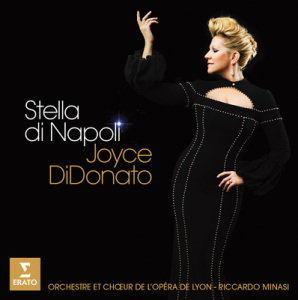This bel canto fiesta is filled with mostly unknown pieces. The only familiar works are Donizetti’s Maria Stuarda, Bellini’s I Capuleti (and one of the melodies from it he had used previously in the unknown Adelson e Salvini), and to a lesser degree, Rossini’s Zelmira. These are hardly household names, but the others are far more esoteric. An aria from Pacini’s unknown title opera is almost a take-off on bel canto opera; it’s a revenge aria, but it is filled with wild flights of silly staccato. We can admire the singer’s skill, but it’s funny, show-offy, gimmicky storytelling.
At the other end of the spectrum is the final scene from the same composer’s Saffo, in which the heroine is about to jump off a cliff; she goes mad. The 14-minute scene goes through many tempo, stylistic (recit, arioso, aria, cabaletta), and orchestral changes before its dramatic finale. Joyce DiDonato gives it great nobility; indeed, she shines in both Pacini selections–as mock-tragedienne (her swooning delivery hints that she knows how absurd it is) and as true tragedienne.
An aria from Bellini’s early opera Adelson e Salvini will be recognized by fans of bel canto as the precursor to Giulietta’s “Ah, quante volte” from I Capuleti; it is sung here with exquisite legato and sinuous tonal beauty. Maria Stuarda’s long scene is pointedly delivered, but wiriness enters the voice on high, forte notes, and a somewhat stressful vibrato creeps in at the middle. Perhaps the role is a bit too heavy for her. She can run all the needed roulades from Zelmira, her trill is still the real thing, and she is incapable of a thoughtless, canary-like reading. A gentle scene from Carafa’s Le nozze di Lammermoor that mirrors Lucia’s first scene from the Donizetti opera (and precedes it by six years) is winsome, tuneful, and features lovely harp and clarinet lines.
DiDonato’s quiet singing throughout the CD is just beautiful, and no matter how silly the text, she infuses it with drama. Romeo’s last-act “Tu sola, o mia Giulietta” from Bellini’s Capuleti is heart-wrenching. A prayer from Mercadante’s La Vestale is sung with gentle intensity, DiDonato’s charisma and superb way with the text making Giunia a real figure.
An aria from Donizetti’s Elisabetta al Castello di Kenilworth has been recorded before (by Renée Fleming and Beverly Sills, to name two) and was occasionally used as a substitute for Lucia’s opening aria. The glass harmonica part here is played by a glockenspiel, but it’s still quite a fine combination of sounds. Again, the text and music may seem at odds–sad vs merry–but our mezzo is so intelligent that we buy it. And of course, it’s gloriously sung.
Riccardo Minasi leads the Lyon forces with elegance and great consideration for his vocalist; a bit more of an aggressive–not sugar-spun–approach may have been preferable. The chorus is spectacular. Strange repertoire, not all masterpieces, but all ear-openers. And what other present-day singer achieves such high marks for both voice and artistry?
































